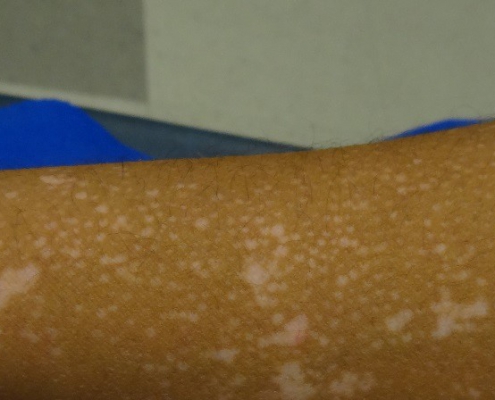Below are images and descriptions of several types of vitiligo. The images and descriptions are designed to give you a general idea of what each type looks like. Do not use this page as a means of diagnosing your vitiligo. Please see a properly trained medical professional, preferably a dermatologist, to make a diagnosis. Please see the general medical disclaimer in the footer of this page.
Generalized
Most common type of vitiligo. This type often starts on the hands, feet, or around the eyes and progresses throughout a person’s life.
In detail…
Generalized vitiligo is the most common type of vitiligo. Approximately 98% of people have this type of vitiligo. It presents symmetrically on both sides of the body such as both sides of the face or both hands. This type often starts on the hands, feet or around the eyes and progresses throughout a person’s life. It may be active and progressive at times and non-progressive and “stable” at other times. This type of vitiligo is usually responsive to medical therapies, especially when treatment is started early (ideally within 12months of the first spot appearing).
In detail…
Segmental vitiligo usually onsets at an early age. About 2% of people have this type of vitiligo. It appears on one side of the body without crossing the midline, and it presents in an isolated segment such as the leg, arm, or face. Segmental vitiligo usually progresses rapidly for about 6 months to a 24 months, and then stops. After this period, segmental vitiligo does not spread any further.
Melanocyte-keratinocyte transplant procedures and other surgical therapies may help repigment segmental vitiligo.
Segmental
It appears on one side of the body without crossing the midline, and it presents in an isolated segment such as the leg, arm, or face.
Trichrome
Trichrome vitiligo consists of white spots with three colors – a central area of white depigmentation, the normal skin color, and a lighter area of skin between the two (called hypopigmented).
In detail…
Trichome vitiligo is often known as a clinical variant of vitiligo with three different sections characterizing its appearance. Namely, there is a zone of unaffected skin with a nearby area or intermediate zone of hypopigmentation. Following this intermediary hypopigmented zone is the depigmented area. Therefore, this triple zoned appearance results in the presentation of three different shades of color on a patient’s skin.
This type of vitiligo heralds active, progressive vitiligo and should be treated as soon as possible.
In detail…
Vitiligo can have various physical manifestations which are often intrinsically linked to the physiological progression of the condition. This is especially true for a form of inflammatory vitiligo known as confetti vitiligo. In this pattern of vitiligo, there are lesions that appear confetti-like and are located near the edges of pre-existing lesions. These particular lesions reflect sudden (acute) damage to melanocytes. They are a sign of aggressive, progressive vitiligo and if left untreated, will rapidly progress to complete depigmentation in the affected areas.
Confetti
Consists of very small spots of vitiligo, usually 1-3mm in size, that often cluster into larger spots, or around the edges of an existing spot.





